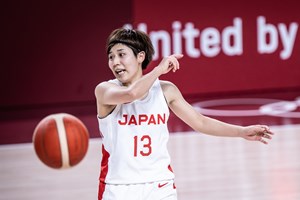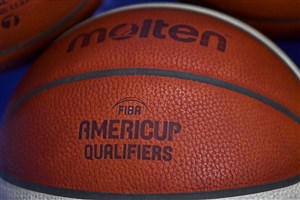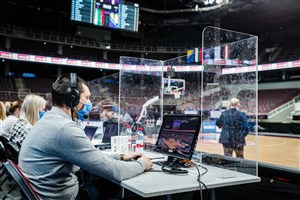
USA and Puerto Rico: protagonists of the '90s
After existing for its first decade, the AmeriCup made a spectacular shift in the 1990s, which started with the arrival of one of the best teams in the history of basketball, featured dramatic tournaments and finals, and saw the birth of a squad that eventually basked in glory.
Held in the city of Portland in the summer of '92, the fourth edition of the continental tournament saw for the first time NBA professionals wearing the national team jersey of the USA. It was a squad that is forever known to all, no matter the language they speak, as the Dream Team.
As was expected, the United States took by storm the entire competition in their path to conquer their first AmeriCup medal, and then continued their feat in the Olympic Games in Barcelona.
 Michael Jordan
Michael Jordan
Icons like Michael Jordan, Magic Johnson, Larry Bird, and others made their mark on the history of the AmeriCup and then extended it to the world, changing basketball history forever.
“The Dream Team ignited interest in basketball around the world,” said the late NBA Commissioner David Stern in 2019 to The Undefeated.
The 1992 AmeriCup was the United States' second appearance in the event after its 1989 silver medal when they lost the final against Puerto Rico. At Portland, Team USA left no room for doubting their supremacy, winning their six games with a 51.5 point per game average, and seven of their players averaging in the double digits. Venezuela was the great surprise of the tournament, as they achieved getting to the final – the first time they ever stepped on a continental podium.
The Dream Team dominated the 1990’s with four tournament titles (1992, 1993, 1997, and 1999), leaving the throne free in 1995 when they didn't go to Argentina.
In 1993, the Puerto Rican capital of San Juan hosted the AmeriCup for the first time since 1980; it's premiere. The Puerto Ricans, who were going through a great moment in international basketball, were willing to recover the crown conquered in 1989, but USA had other plans for the final game (109-95). Even so, Puerto Rico stayed in the first spots of the continent, and qualified consecutively to World Cups (1986 and 1990) and Olympic Games (1988 and 1992), plus winning the gold medal in the 1991 Pan American Games in Havana.
Puerto Rico was the other country that was able to win the AmeriCup in the decade when, in 1995, with a second group of players, but led by stars José “Piculín” Ortiz, Jerome Mincy, and Ramón Rivas, took the gold in the tournament held in Neuquén and Tucumán.
 José ''Piculín'' Ortiz
José ''Piculín'' Ortiz
Months before the feat, eleven players of the leading Puerto Rican team had been suspended for the incidents occurring at the Pan American Games in Mar del Plata, when the group claimed the outstanding payments owed by the local federation. For several weeks the island was in a buzz about what team they would be taking to the games since there were only three AmeriCup spots available for the Atlanta Games. In other words, stepping on the podium was a must if a team wanted to be in the 1996 Olympics.
Only three days before the tournament started, the decision came: the penalties for the players would prevail. Puerto Rico went with their three leaders (Ortiz, Mincy, and Rivas) and nine players more, some national team rookies, and other veterans that responded to the call. Puerto Rico surprised everyone by winning the tournament with a 9-1 record, the only defeat being a 35-point loss against Argentina in the second round of the competition. They then defeated the Argentines in the final by a tight 87-86. Argentina had in their ranks young players Fabricio Oberto and Rubén Wolkowyski, who would later become Golden Generation players, taking their first steps in the national team.
“It was a very satisfying tournament because of the way that we won the medal," remembered in 2017 coach Carlos Morales at the En la Pintura Deportes podcast. Morales coached Puerto Rico from 1993 to 1999.
Ortiz was the spearhead for the Puerto Ricans, who won the prestigious continental title for the third time – the last time up to this date. "We went with players that were committed. We all chipped in, and we were successful. "The Neuquén fans were very generous with us,” said Ortiz.
The 1995 AmeriCup was the end of the continental career of one of the greats of international basketball: Brazilian legend Oscar Schmidt, who bid farewell the national team in the 1996 Olympics.
 Oscar Schmidt
Oscar Schmidt
In 1997, Montevideo welcomed the AmeriCup just as it had done nine years before (1988). The USA and Puerto Rico once again starred in the final and fought for the continental title for the third time, although both teams traveled different roads to get to the game. After an unexpected loss in the debut game against Venezuela, United States devastated its competition and won the following seven games, winning its third AmeriCup championship. As for Puerto Rico, they played their third consecutive continental final of the decade after being on the verge of being eliminated from the tournament's regular phase. But victories against Argentina and Brazil at the start of the tournament's second stage raised morale among the Puerto Ricans, who were able to, once again, step up on the podium. Meanwhile, Brazil, twice champions in the 1980s, added their third bronze medal in four editions.
In 1999, the AmeriCup came back to the Roberto Clemente Coliseum in San Juan, but this time with a special formula. After losing their world title in 1998, and with only two available spots for the 2000 Sydney Olympics, USA reached out to their NBA talents to recover their throne in the Americas. With names like Tim Duncan, Kevin Garnett, Jason Kidd, and others, Team USA left no room for surprise and won the tournament undefeated (10-0).
 Jason Kidd
Jason Kidd
The United States were the favorites to take the gold and one of the Olympic tickets. The rest of the continent battled for the honor of a silver medal and the other available ticket for the Olympic event of the following year. Puerto Rico seemed to be favored by the fact that they were playing at home and their 5-0 undefeated record. Still, a loss against Canada in the semi-finals hindered the possibility of a new showdown against the United States for the title. Canada, whose team was led by point guard Steve Nash, took the other ticket for Sydney 2000.
 Steve Nash
Steve Nash
Although left out of the Olympic dream, the 1999 AmeriCup was of great benefit to Argentina. This tournament was the first in which the South American team gave the reigns of the squad to a young group that made history at the youth level, and that had excellent projection. Manu Ginóbili, Andrés Nocioni, Luis Scola, Wolkowyski, Oberto, and others, made their way to the continental bronze. But more than that, they took the first step into what would be a golden history that written throughout the following decade.
In short, in the ‘90s, the AmeriCup saw the United States become their greatest champion, with four titles. Puerto Rico, for their part, played in three finals, including the 1995 gold, and were the only national team to be among the first four spots in all the editions held in the decade. Argentina added two bronze medals, one silver, and built the foundation for the memorable successes that would arrive years later. Venezuela (1992) and Canada (1999) had the honor of accompanying the American teams built with NBA players.
Without a doubt, the '90s left their mark on the AmeriCup and changed the course of what basketball would become in the following century.
Marcos Mejías Ortiz / FIBA












